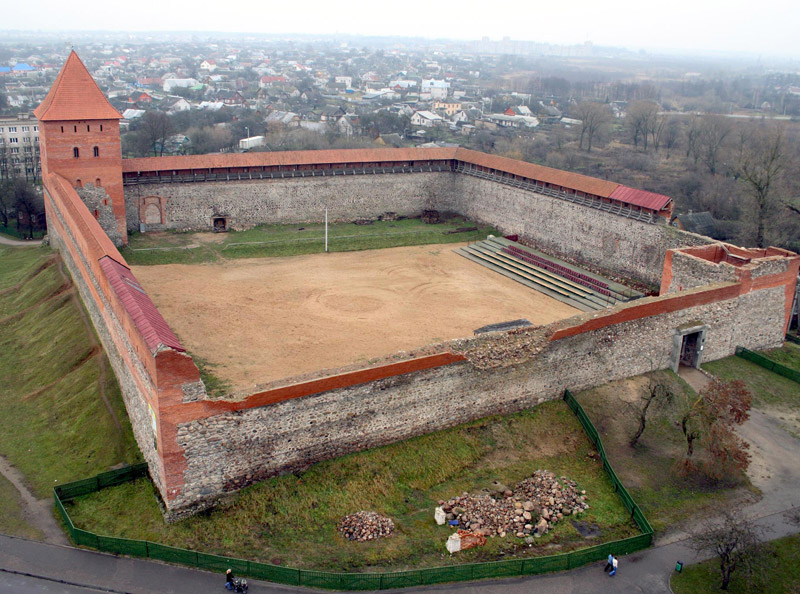

Location: Lida, Hrodna Oblast Map
Constructed: 14th century by Grand Duke Gediminas
Lida Castle (Belarusian: Лідскі замак; Lithuanian: Lydos pilis; Polish: Zamek w Lidzie) is a medieval fortress located in the city of Lida, Grodno Region, western Belarus, at an elevation of 141 meters (463 ft) above sea level. Constructed in the early 14th century as part of a defensive network by Grand Duke Gediminas of Lithuania, it stands as one of the best-preserved examples of medieval defensive architecture in Belarus, symbolizing the region's resilience through centuries of conflicts. The castle, built on an artificial sand hill at the confluence of the Lida (Lidae) and Kamenka rivers, features a rectangular layout with robust walls and towers, covering an inner courtyard of approximately 80m x 80m. It was designed to protect against invasions, particularly from the Teutonic Knights, and control key trade routes. Today, it serves as a major cultural and tourist site, hosting medieval reenactments, exhibitions, and seasonal events, while housing a branch of the Lida History and Art Museum.
The history of Lida Castle begins in 1323, when Grand Duke Gediminas
of Lithuania ordered its construction as part of a chain of
fortresses—including Kreva, Medininkai, and Trakai—to defend the Grand
Duchy against the Teutonic Knights' expansion. Built on an artificial
mound surrounded by rivers and bogs for natural defense, it quickly
became a strategic stronghold. The town of Lida developed around it,
underscoring its central role in regional administration and trade.
In the 14th and 15th centuries, the castle witnessed significant events.
In 1387, Polish King and Grand Duke Jogaila (Jagiello) received an oath
of allegiance from his brother Skirgaila there. It withstood sieges by
the Teutonic Knights in 1384, 1392, and 1394, though it was captured
twice. In 1406, it held hostages from the family of Yury of Smolensk
during a failed liberation attempt. Grand Duke Vytautas granted it to
his ally, Khan Tokhtamysh, who settled nearby. In 1422, Jogaila married
his fourth wife, Sophia Golshanska, at the castle. Internal conflicts
arose in 1433 between Švitrigaila and Sigismund Kęstutaitis. In 1506, it
was ravaged by Crimean Tatars, and the mortally ill King Alexander
Jagiellon signed his testament within its walls.
The 16th to 18th
centuries brought further turmoil. During the Russo-Polish War
(1654–1667), Russian forces under Ivan Khovansky besieged and stormed it
in 1659. Under King Jan Kazimierz of the Polish-Lithuanian Commonwealth,
Lida gained Magdeburg rights, and the castle housed garrisons, weapon
warehouses, and courts. During the Great Northern War (1700–1721),
Swedish troops captured it twice and blew up both towers in the early
18th century, leading to decay. In 1794, during the Kościuszko Uprising,
rebels fought Russian troops amid the ruins, causing more damage.
In
the 19th century, after a devastating fire in Lida in 1891, locals
dismantled parts of the southwestern tower and western wall for building
materials, prompting intervention by the Imperial Archaeological
Commission and architect Petr Petrovich Pokryshkin to halt the
destruction. Early 20th-century repairs (1909–1911) focused on the
western, northern, and eastern walls.
The 20th century saw varied
uses and protections. Under Polish rule post-1921 Riga Treaty, restorers
like Tadeusz Bursche repaired walls in the 1920s and added features like
wooden gates. It hosted circuses, menageries, Christmas trees, and ice
rinks. Designated an architectural monument on January 22, 1940, it
briefly served as a POW camp in 1941 during World War II. Post-war, it
was protected in 1953 and transferred for restoration in 1967.
Lida Castle exemplifies Romanesque-Gothic defensive architecture of the 14th–15th centuries, with a trapezoidal (nearly square) plan measuring about 93m x 84m. Constructed from boulders and later faced with red brick, the walls reach up to 12m high and 2m thick, featuring battlements, loopholes, and embrasures for defense. Originally, it had two prominent corner towers: a southwestern one (13m x 13m) for the main entrance and a southeastern one (12m x 12m). The towers' upper storeys served as living quarters, and a church was initially inside but relocated outside in 1533. A surrounding moat, fed by the rivers, added protection, though it was later filled. The courtyard, now covered in sand and gravel, was used for daily activities and defense. Wooden galleries along the walls allowed for patrolling, and the design emphasized functionality over ornamentation, typical of Lithuanian fortresses.
Unique features include its foundation on sand, which has remarkably withstood centuries, and preserved elements like carved stone fragments reflecting medieval Lithuanian style. The castle's strategic riverside location and role in a defensive line (e.g., with Novogrudok) highlight its importance. Legends abound: one tells of Prince Dmitry Karibut, whose defenders perished during a siege, their ghosts reportedly haunting the walls, especially in fog. Another involves sacred pines in the courtyard, grown from a burial pit of Catholic missionaries; locals believe the trees bleed if cut and hold them in reverence.
Restoration efforts intensified in the late 20th century. Work began
in 1978 but paused in the mid-1990s due to funding. Resumed in 2006, it
accelerated for the 2010 "Dozhinki" festival, completing walls and the
southwestern tower with wooden galleries and tiled roofs. By 2010, it
was 87% restored, with full completion targeted for 2019. Recent phases
used red brick for new sections to distinguish them from originals,
focusing on historical accuracy.
As of 2025, Lida Castle is fully
restored and operates as a vibrant cultural center. It hosts annual
medieval knight tournaments in summer, ice-skating in winter, historical
reenactments, fairs, and exhibitions on the Grand Duchy's heritage. The
towers house a museum with artifacts, and it's open year-round,
attracting thousands of tourists. Coordinates: 53°53′13″N 25°18′10″E.